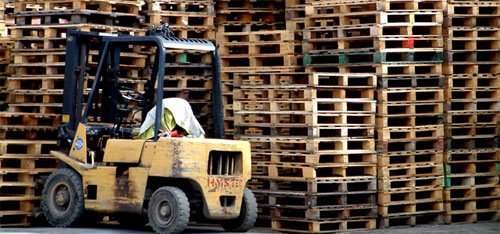 One of the most important things you can do for your forklift is to check the wear of the tires. Pneumatic and Cushion tires wear differently, here at Pete’s Tire Barn we want to stress tire safety, replace your forklift tires when your tires experience any of the conditions listed.
One of the most important things you can do for your forklift is to check the wear of the tires. Pneumatic and Cushion tires wear differently, here at Pete’s Tire Barn we want to stress tire safety, replace your forklift tires when your tires experience any of the conditions listed.
Pneumatic
- Simple wear – The 2-inch rule can still be used for pneumatic tires but when checking you should be aware that due to pneumatic tires being used outside they have wider size variances and more complex tread patterns for their application.
- Balding – A better rule however is to check the tread itself. Tires wear differently based on how they are used and how well the wheels are aligned, but smooth centers and lug or tread showing are signs of wear.
- Cuts – If there are visible gashes or cuts in the tread pattern, replacement should be considered immediately. Cuts can lead to sudden air loss, load shifts, and improper balance
- Over Inflation/Under Inflation Before inflating or deflating your tires, check the recommended tire pressure, this can be found on the sidewall of the tire.
- Over Inflation – Will result in less stopping power as the tire will make inconsistent contact with the ground. Over inflation will also lead to uneven wear in the center of the tire.
- Under Inflation – Leads to a raised difficultly in making smooth turns while carrying a load. • Uneven wear and decreased fuel efficiency.
Cushion or Press on Tire
- Simple wear – A standard way to check for simple wear is to follow the 2-inch rule. First, check the tires original size, this can be found on the sidewall of the tire. Now measure the current height of the tire, if the current height is more than two inches lower than the original height it is time to start thinking about replacing your tires.
- Chunking/Cracks – Litter, debris, and misuse can lead to pieces of the tire falling off. If this damage is affecting the ride and traction of the forklift than you should think about removing your tires.
- Tearing/Splits – Contact with sharp objects or bad dock plates and can be potentially very dangerous. This results in large, wide but usually not deep chunks missing from the tire.
- Flat Spots – Flat spots are a common issue with passenger and light truck tires and are cause by misalignment. This is similar with forklift tires, if the wheels aren’t properly aligned or your operators are making sharp stops with heavy loads this can lead to flat spots.
We have 20 locations to service all of your forklift truck tire needs. Call your local Pete’s Tire Barns today and schedule a visit from one of our industrial tire experts.





